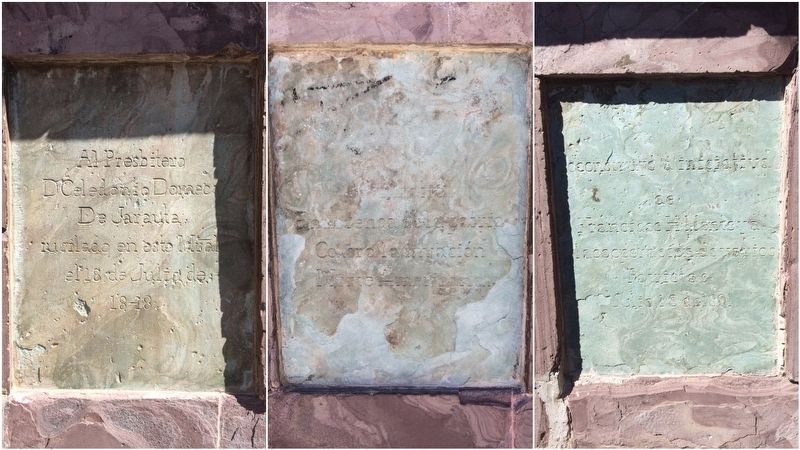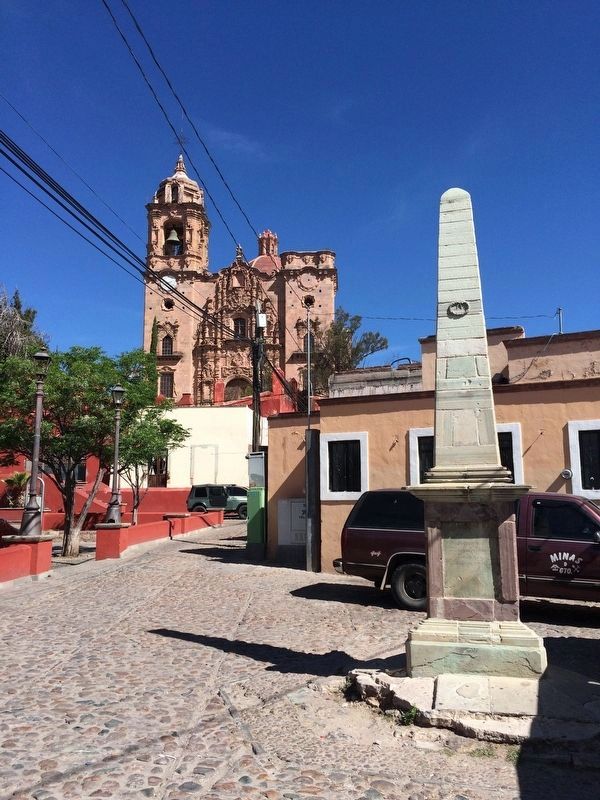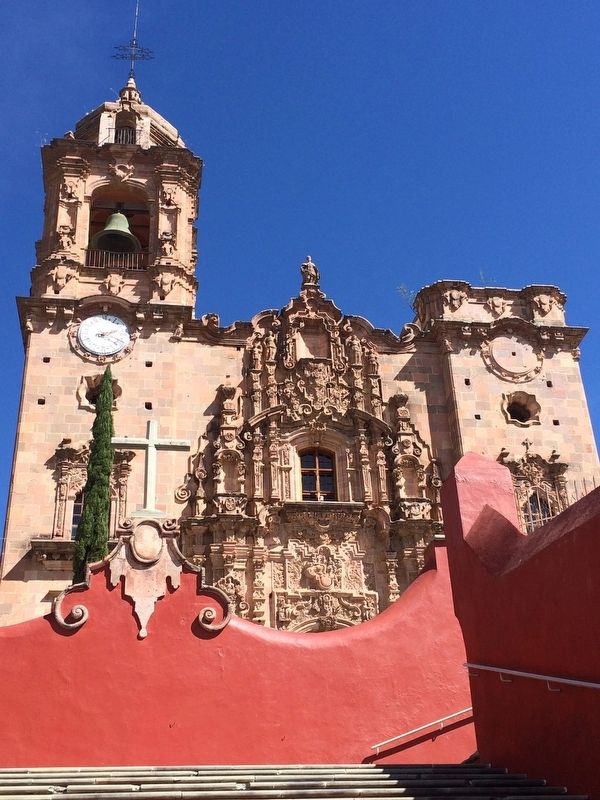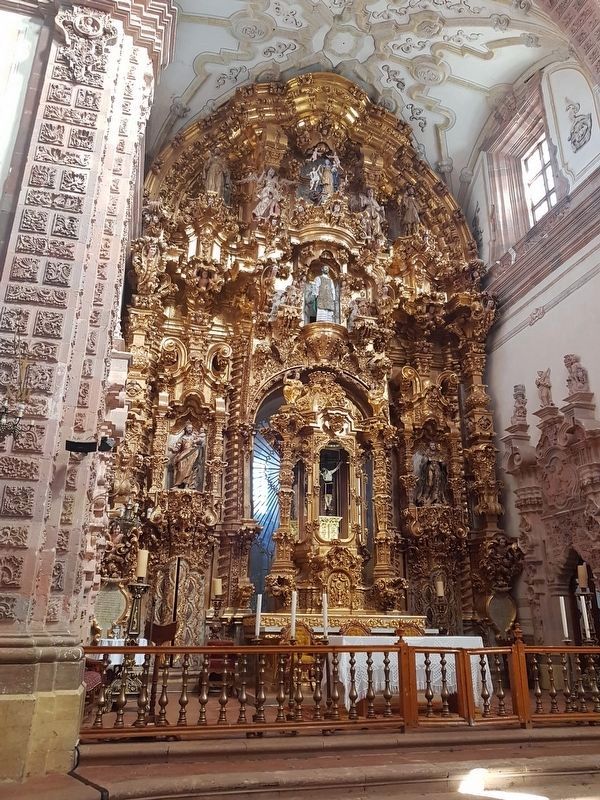Guanajuato, Mexico — The Central Highlands (North America)
Celedonio Doméco de Jarauta
Inscription.
D. Celedonio Domeco
de Jarauta
fusilado en este Mral
el 18 de Julio de
1848.
Combatió
En defensa de la patria
Contra la invasión
Norte Americana
Se construyó a iniciativa
de
Francisco H. Montoya
y la cooperación de varios
patriotas
Julio 18 de 1891.
executed by firing squad here on July 18, 1848.
He fought in defense of the motherland against the North American invasion.
This monument built through the initiative of Francisco H. Montoya and the cooperation of other patriots
July 18, 1891.
Erected 1891 by Francisco H. Montoya y la cooperación de varios patriotas.
Topics. This memorial is listed in this topic list: War, Mexican-American.
Location. 21° 2.452′ N, 101° 15.425′ W. Marker is in Guanajuato. Memorial is at the intersection of Calle San José and Calle Boca, in the median on Calle San José. The marker is some meters south of the Church of San Cayetano de Valenciana, located towards the north of the city center of Guanajuato. Touch for map. Marker is in this post office area: Guanajuato 36000, Mexico. Touch for directions.
Other nearby markers. At least 8 other markers are within 3 kilometers of this marker, measured as the crow flies. Tepetapa Bridge (approx. 2.4 kilometers away); Lieutenant José Francisco Valenzuela (approx. 2.4 kilometers away); Casimiro Chowell J. (approx. 2.4 kilometers away); 200 Years of the Consummation of Mexican Independence (approx. 2.4 kilometers away); 125 Years of Water as a Public Service (approx. 2.4 kilometers away); The Burning of the Alhóndiga de Granaditas (approx. 2.4 kilometers away); The Cemetery of the Convent of the Temple of Bethlehem (approx. 2.5 kilometers away); Rafael López (approx. 2.5 kilometers away). Touch for a list and map of all markers in Guanajuato.
Regarding Celedonio Doméco de Jarauta. Celedonio Dómeco de Jarauta, (1814-1848), was a Spanish soldier, Catholic priest and later a Mexican guerrilla leader in the Mexican American War. He was born in Zaragoza, Spain on March 3, 1814. He fought as a Carlist in the First Carlist War in Spain. He emigrated to Havana, Cuba, and took Holy Orders becoming a priest. In 1844 he was granted a parish in Veracruz, and immigrated to Mexico. In 1847, when the Americans landed near Veracruz, he was appointed chaplain of the 2nd Infantry Regiment, then later he was named to head of the field hospital. After the fall of the city he went into the countryside and organized companies of guerrillas that harassed American
convoys, small parties and couriers between Veracruz and Puebla especially in the Sotovento region, the coastal plain of the state of Vera Cruz. After the fall of Mexico City, on January 19, 1848, Jarauta published a broadside, in Puebla, "Viva la República Mexicana: Mexicanos", a patriotic call for continuing resistance to the U.S. forces in Mexico. After the peace treaty of Guadalupe Hildalgo was concluded on February 2, 1848, Jarauta refused to acknowledge it. On February 25, 1848, an American force under Gen. Joseph Lane made a forced march which surprised and defeated the force of Padre Jarauta at Zacualtipan in the Action of Sequalteplan. Opposed to the treaty and the policies of President Manuel de la Peña y Peña, he joined General Mariano Paredes, Manuel Doblado and others in armed revolt, but they were defeated by the remaining Mexican Army under General Anastasio Bustamante at Guanajuato on July 18, 1848. Jarauta was captured while on a reconnaissance of the neighborhoods of Mellado and La Valenciana and shot for revolutionary activities on Bustamante's order the next day by Mexican troops here near the La Valenciana Mine on July 19, 1848. Adapted from Wikipedia
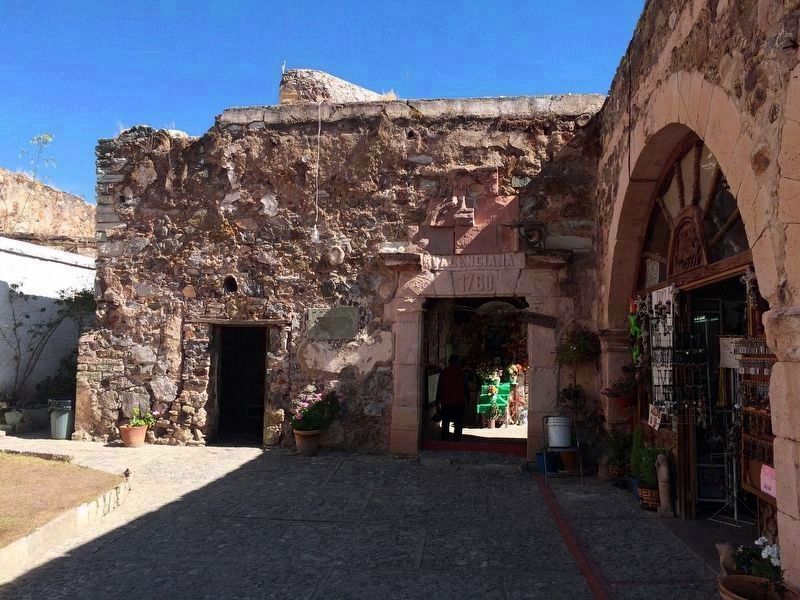
Photographed By J. Makali Bruton, April 3, 2017
4. The nearby Valenciana Mine, some meters north of the featured marker.
Doméco was caught near the Valenciana Mine, once the site of the production of two-thirds of all silver in Mexico. To the left of the mine entrance is an additional marker, which reads:
En XXIII. de junio de
1803. Estuvo en este
lugar. El Exmo. Sep
D. Jose Yturricarai
Virey. de N. Esp.
On June 23, 1803 José Iturrigaray, Viceroy of New Spain, visited here.
En XXIII. de junio de
1803. Estuvo en este
lugar. El Exmo. Sep
D. Jose Yturricarai
Virey. de N. Esp.
Credits. This page was last revised on October 8, 2018. It was originally submitted on June 28, 2017, by J. Makali Bruton of Accra, Ghana. This page has been viewed 437 times since then and 36 times this year. Photos: 1, 2, 3, 4. submitted on June 28, 2017, by J. Makali Bruton of Accra, Ghana. 5. submitted on October 8, 2018, by J. Makali Bruton of Accra, Ghana.
